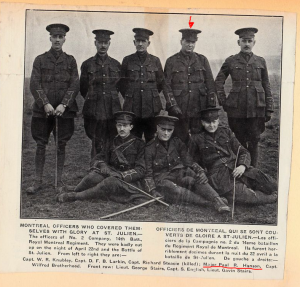Sunday, March 14, 1915
In billets, Rue du Quesne
The Battalion War Diarist wrote for this day: “Same billets as last time out. Weather fine.” [1]

THIS DAY IN RMR HISTORY: Division Occupied Trenches Vacated by Guards Regiments and Welsh Borderers – Sixty Yards to Prussians – Major Paul R. Hanson Writes of Life at the Front – Lost Six in One Company in Ten Minutes.
“How the Canadian division now at the front replaced some of Britain’s best regiments in the trenches opposite the Prussians is told in a letter which has just been received from Major Paul R. Hanson, of the 3rd Brigade, Canadian Field Artillery. (sic)* The division, he says, covers a frontage of two miles.
Before leaving for the front, Major Hanson was Montreal manager of the Dunlop Rubber Co., and was also treasurer of the Montreal Automobile Trade Association. His letter, which is dated France, Sunday, March 14, follows:
‘I have had my fourth tour of duty in the trenches in two different parts of France, and I might say that the Canadian division have been out in the parts of the firing line that was looked after by England’s best regiments. The Grenadier Guards, the Scots Guards, and the Welsh Borderers. In my dug out I relieved Lord Dublie, and it was the trench the Prince of Wales had with his company.
We cover a frontage of two miles, and go in for four days and four nights, and never take our arms or clothes off. Our rations are brought up at night and cooked in the trenches. We are all the time working, improving and strengthening them, though they have been nearly in the same place for five months. We have to pump and use pails to keep the water down.
In some places you can sink waist deep in the mud, and they are very low, as if they are high they are shelled down. On our left we are only 60 yards from the Huns and the longest distance is 300 yards, all barbed wire and catch wire in front, which we repair at night, and it’s a ticklish job, I can tell you. They send up a flare, and you drop to the ground, if they see you they turn on the Maxim gun.
Company Lost Six Men in Ten Minutes – The Germans have lots of men who worked in England, and can speak good English, and our men call over, ‘waiter, sausages for two,’ and such calls. It gets them mad, and they open up at us; then we sing Rule Britannia, and the Maple Leaf, etc.
We attacked on our right flank on Monday, and the Royal Highlanders (regular) captured two trenches. We are near a place that was taken two days ago, and the casualties are awful. I have helped to bandage and give first aid to lots of poor fellows. I lost six in my company in ten minutes.
Their snipers are wonderful shots. Every man who straightens up gets one through the head sure. I put my own cap above the parapet on a stick, and it wasn’t up two seconds when two bullets went through it. I am glad my hat had not my head in it.
We are well looked after, but the Canadian troops do not get enough to smoke, and if you could send any of your boy friends who you know, a few packages now and again you could not give them anything that would please them better.
Our heavy guns are behind us, and fire right over the house I am now in, and if you saw this place – not a stick of furniture, the Germans cleaned out everything. The men are in a barn with no roof. It has all been shot away, and today the chimney was shot off this house.
Are used to Shell Fire Now – You know how you walk along the street and hear the honk of a motor car. Well, a 60 pounder has no more effect on a man than that. When we fire or they fire a 13-inch gun, the projectile, which weighs 450 pounds, comes along with a roar, and the boys say, change cars for Dominion Park, or St. James Street. They call them street cars or freights, and say another souvenir for the Germans, and in goes the trench or down comes a house or barn, and we cheer and pop at them as they run.
We occupied the trenches at first with the regulars to get us used to fire. It was the same regiment who had the Xmas truce. They talk to each other all night, and say ‘hello, is Carl there?’ The Germans ask for Bill Smith, etc. They know each other well, and then the next moment they are at it again. The Bavarians are not bad. They don’t want to fight the English. It’s the Prussians who are the blood-thirsty lot. They are opposite us now. Why the Bavarians wanted the English to shoot in the air, and they would do the same, as most of them have lived in England most of their lives.” [2]
* Note: Major Paul R. Hanson was a company commander with the 14th Battalion at this time.
[1] War Diary, 14th Canadian Battalion, The Royal Montreal Regiment, March 14, 1915. Library and Archives Canada, Ottawa, http://data2.collectionscanada.ca/e/e044/e001089701.jpg
[2] “Canadians in Place of Britain’s Best,” The Journal of Commerce, Montreal, Quebec, Wednesday, April 7, 1915, pg. 6, col. 5

